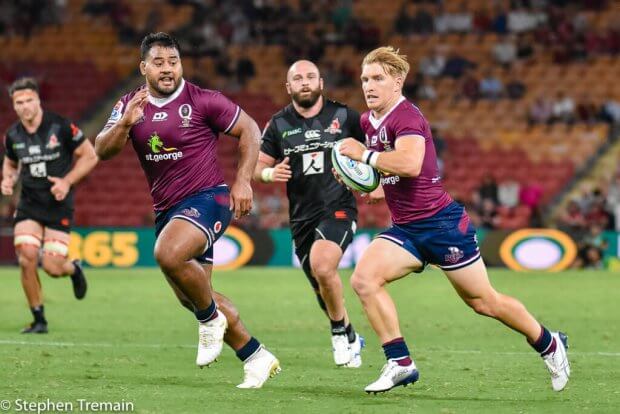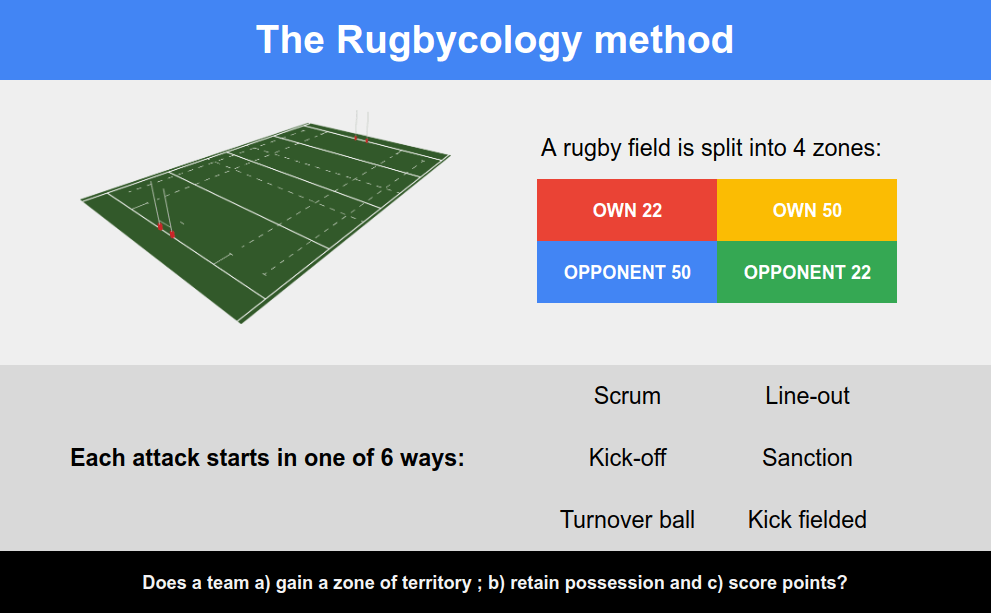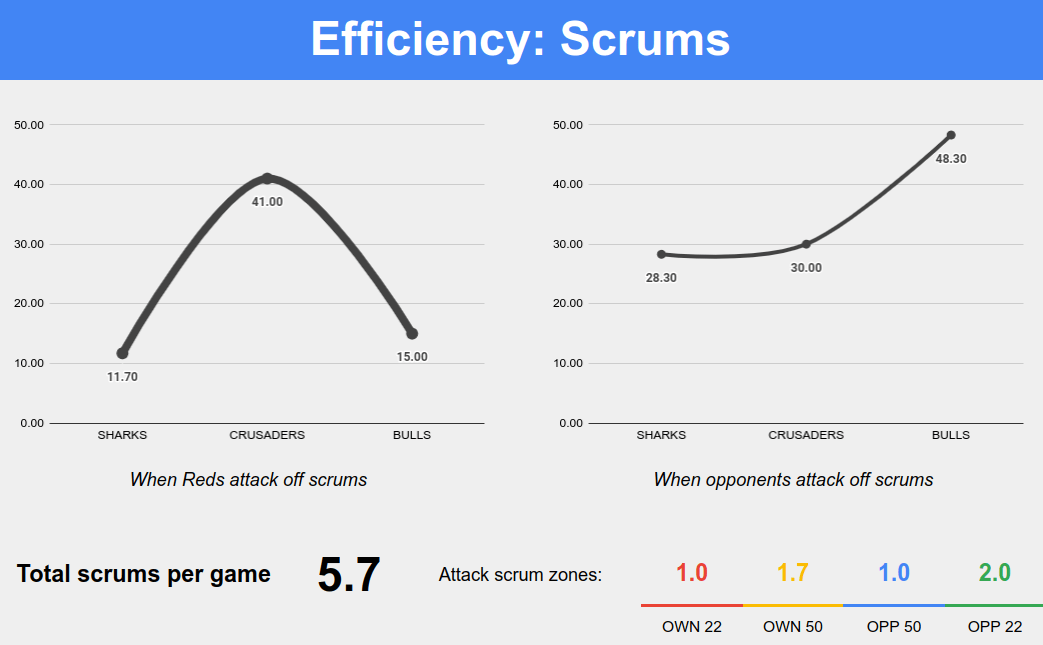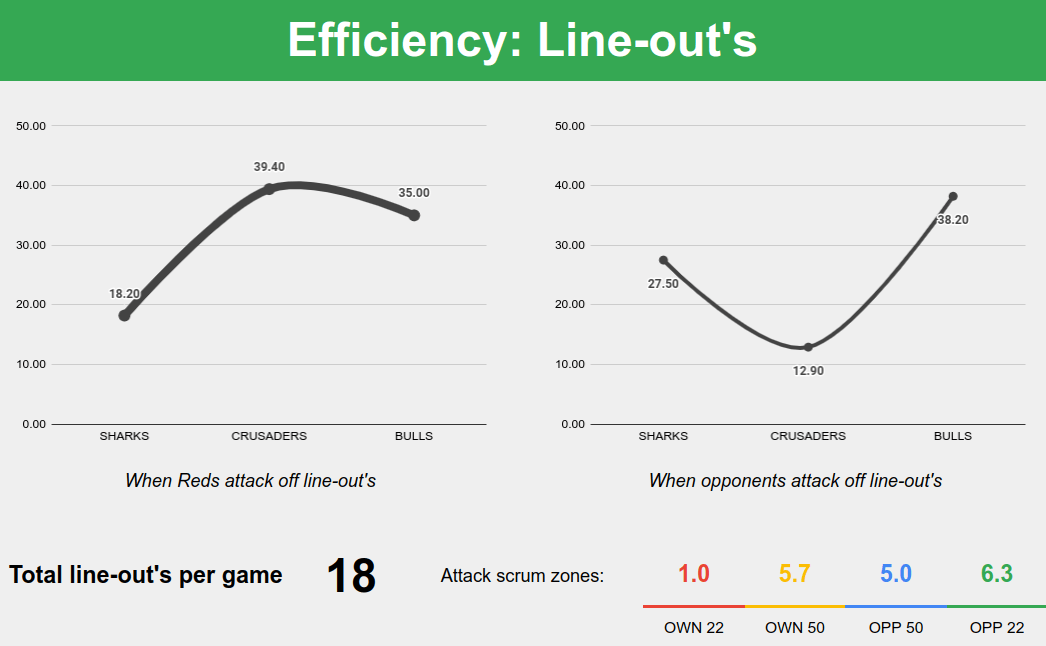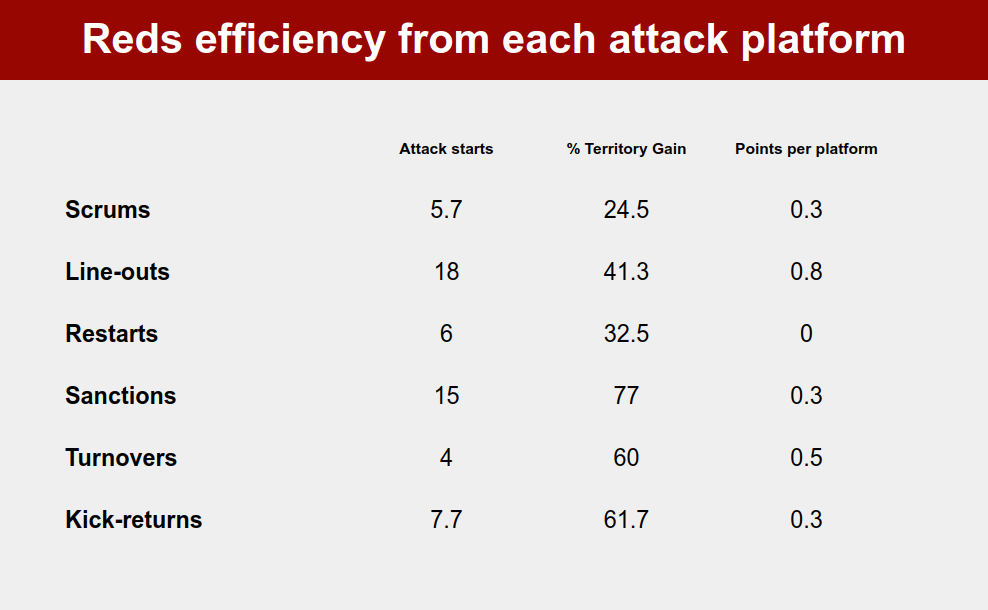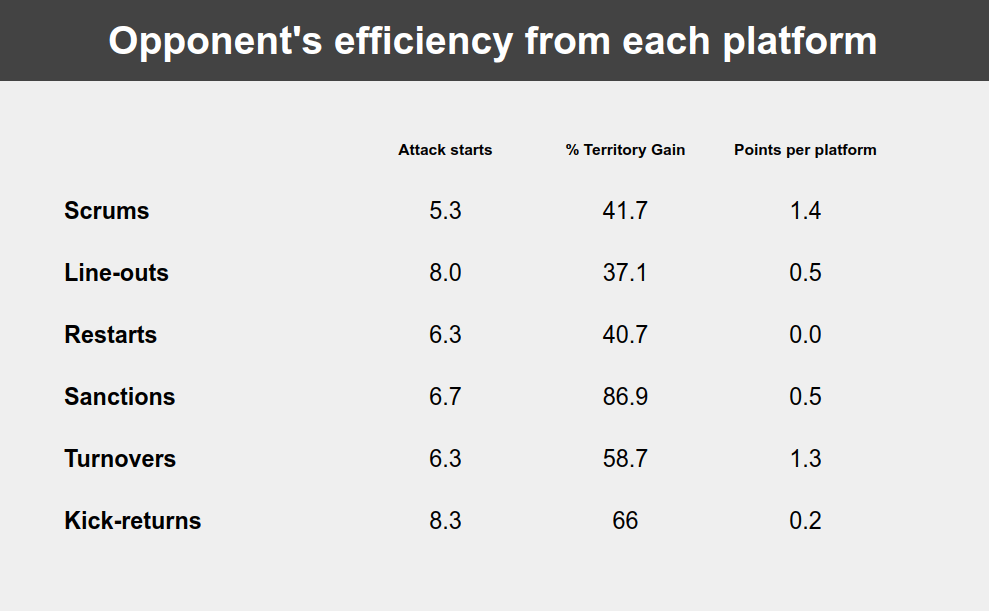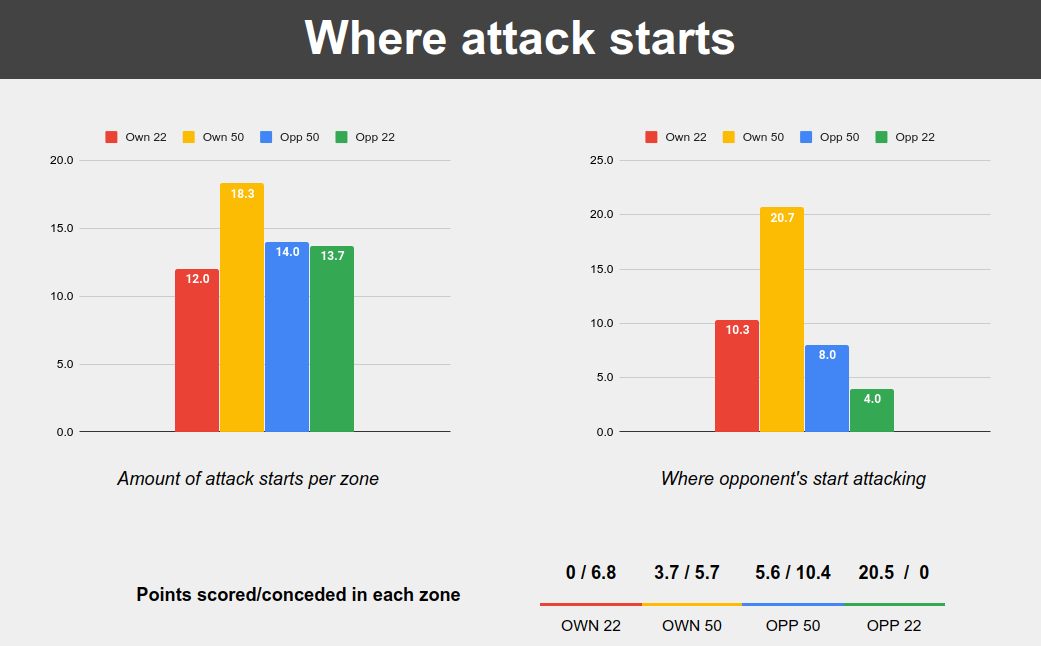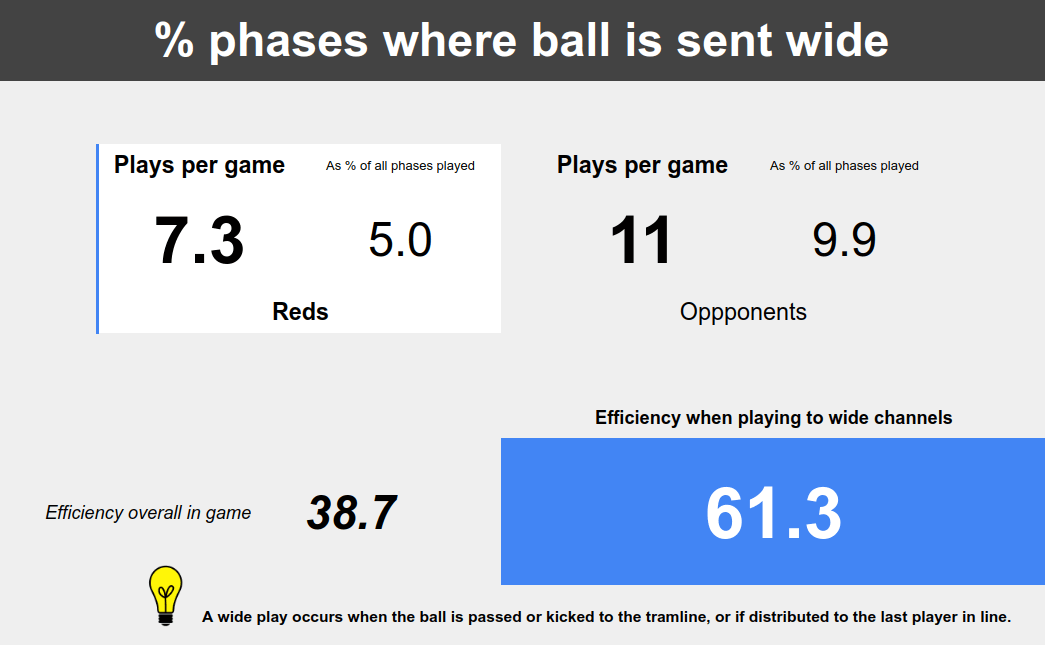Up in Queensland there is something brewing. I am not sure if the fans just WANT to believe that their team’s fortunes are about change, or whether between the 4 lines a revolution is indeed being manifest.
It is therefore worth our while to look at the Red’s current form and study their performance between the four lines in relation to their 3 last opponents, from the Sharks to the Bulls, with their trip to Christchurch sandwiched in-between. To study the Reds’ form, I will look at how ‘efficient’ they are, using my rugbycology method.
To measure a team’s efficiency, I split the field into 4 zones, and then study each of the 6 platforms team’s attack or defend from. Because the game is nuanced and has so many variables, I sidestep metrics like ‘gainline efficiency’ or ‘meters made’, and there is a good reason for that.
Say for example a lock makes a line-break and runs 10 meters up-field, his ‘stats’ will record that he made a line-break, broke a tackle and ran 10 meters. What the stats do not reveal is whether or not his team managed to recycle that ball and play on. In short, we do not know if the line-break resulted in an efficient play or not?
Therefore to determine the efficiency of any attack (or defense) platform from any field-zone, I look at where (and how) it starts, and where it ends.
Each platform is then judged based on the following criteria:
Did they gain a zone of territory?
Did they retain possession?
Did they score 3, 5 or 7 points?
To get a 100% efficiency rating a team must therefore gain territory, keep the ball, score a try and convert it.
Above we then look at the Red’s scrum efficiency, and that of their opponents. While the Reds do not attack off scrums that often in games (10% of all platforms), the do seem to struggle off this set-piece. This brings into question claims that the Reds have the best scrum in the competition.
My early hunch is that the Reds dominated early season exchanges in the scrum. However after a while pack’s start scrumming to win penalties instead of using the scrum as an attack platform. It will not take long for this strategy to bomb because the mindset going into the scrum is already negative.
Above we see the Red’s attack off a whopping average of 18 line-out’s per game, of which 11.3 occur in their opponent’s halve. After the Sharks fiasco the Reds started posting above 30% efficiency ratings and had a brilliant line-out performance against the Crusaders where the Reds not only attacked with great efficiency but also prevented the ‘Saders from launching efficiency attacks off this vital set-piece.
“You have to do well that which you do a lot off.” That is the mantra, and in this regard the Reds’ future success will depend a lot on them improving the efficiency of their line-out, because they choose to attack from it so often. (31% of all attacks are launched from line-out’s)
Above is a summary of the Reds attack platforms over the past 3 games. Of particular interest here is that the Reds attack off only 7.7 kick-returns per game, whereas the average in the Six Nations in 2020 is 22.8! Let’s just say Super Rugby is very different to the tactical hotbed that is Six nations rugby.
Now the territory gain % is a fascinating yet simple metric. If a team for example starts 10 attacks in their own 50m area, and manage to progress into their opponent area 8 times out of the 10, their gain % will be 80%. It is remarkable therefore that the Reds have a 61.7% gain rate from kick-returns and and 60% gain from turnovers, yet off set-pieces achieve a lot less.
Let’s compare how their opposition fared:
Bam! Can you see how few penalties the Red’s opponents get to attack from compared to the Reds? The problem is the opposition gains more territory from sanctions, but this is understandable considering the Reds played 2 South African sides who both played 10’s who can kick the ball a mile.
Too often the Reds kickers do not kick the ball far enough into touch from penalties, and these small things tend to add up. I will also not hammer too much on the fact that the Reds scored a grand total of 3 points from the 25 penalties they earned in their opponent’s halve over the past 3 games.
What stands out for me from the above two graphics is how many points the opposition score against the Reds from turnover ball. Defence-coach Peter Ryan will want to pay close attention to the team’s alignment once the ball is turnover over, because it happens on average 6.3 times per game – more than scrums!
I am impressed by the Red’s territorial awareness this season. Playing in the right area of the field is the bedrock on which all else is built, and so-far the Reds always manage to carve plays in their opponent zone while preventing their opponents too many entries into their own zone.
Of concern is that the Reds mostly score only from their opponents 22 area. This means they work hard for scores and cannot convert breaks from any other areas. In contrast their opponents score on average 10.4 points from their own 50m area (Red’s OPP 50 Zone).
The great teams, and here I am referring to the Crusader’s/Leinsters/Saracens of this world can manufacture scores from any platform and any zone. It is what distinguishes great teams from good ones. In this respect the Reds are still in their development phase as they currently only score off line-outs and mostly only in their opponent 22.
What I find perplexing about the Reds right now is how effective they are when they play wide (to the tramlines), yet how few times they do so.
Above we see the Reds play on average 7.3 times to the wide channels, or only 5% of all phases will go wide. Their opponents chose this option 11 times per game, at 9.9% per phase.
The overall efficiency of the Reds currently is 38.7%, yet in playes when they go wide, they achieve a 61.3% efficiency grade. I suppose that’s what happens when you have a world class winger on your books.
The question then is why the Reds only manage to do this 7.3 times per game? With Kerevi around it made sense to punch up the middle, and perhaps the disruptions to the Reds’ backline due to injuries played a role. He data however clearly shows that there is some gold to be mined out wide, and I hope the Red’s continue to develop this aspect of their attack.
Summary of Reds immediate work-on’s:
> Develop attack off scrums and stop scrumming for penalties
> Continue improving the line-out attack/defense as has been the case in past 2 games
> Work on hand-speed to get the ball wide a bit more often.
> Get kicker’s confidence up.
Brendon Shields is a professional rugby analyst and researcher of schools and club rugby. He develops online tools to help coaches at community level improve their teams using basic science. @brendonshields – to learn more about Rugbycology, visit rugbycology.com

